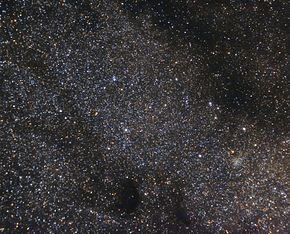NGC 6603
| NGC 6603 | |
|---|---|
 NGC 6603 (bottom right) in Messier 24 | |
| Observation data (J2000.0 epoch) | |
| Right ascension | 18h 18.4m |
| Declination | −18° 25′ |
| Distance | 10 kly |
| Apparent magnitude (V) | 11.1 [1] |
| Apparent dimensions (V) | 5′ |
| Physical characteristics | |
| Other designations | Collinder 374 |
| Associations | |
| Constellation | Sagittarius |
NGC 6603 is an open cluster discovered by John Herschel on July 15, 1830[2] located in Sagittarius constellation.[3]
Situated within the brightest part of star cloud Messier 24, it is classified by Shapley as type "g". This cluster consists of about 30 stars in a field of about 5 arc minutes in diameter, and is about 9400 light years remote. Thus its linear diameter should be about 14 light years. The hottest stars are about B9 (pointing to an intermediate age of several 100 million years, an estimate of which is not known to the present author), and the brightest of photographic mag 14.
Many sources improperly identify NGC 6603 as Messier 24.[4]
References
[edit]- ^ "ngc 6603". sim-id. Retrieved 2020-06-10.[permanent dead link]
- ^ Seligman, Courtney. "Celestial Atlas: NGC Objects 6600-6649". cseligman.com. Archived from the original on 9 September 2015. Retrieved 2 July 2015.
- ^ Rojas, Sebastián García. "Open cluster NGC 6603 - Open Cluster in Sagittarius Constellation". Telescopius. Retrieved 2019-12-26.
- ^ "Messier 24". messier.seds.org. Archived from the original on 2023-04-16. Retrieved 2020-09-27.
External links
[edit] Media related to NGC 6603 at Wikimedia Commons
Media related to NGC 6603 at Wikimedia Commons- NGC 6603 on WikiSky: DSS2, SDSS, GALEX, IRAS, Hydrogen α, X-Ray, Astrophoto, Sky Map, Articles and images


 French
French Deutsch
Deutsch